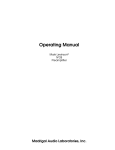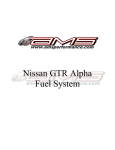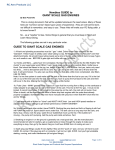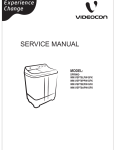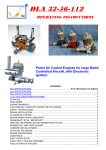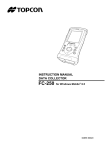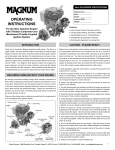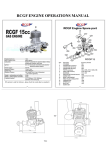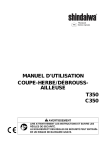Download Operating Instructions
Transcript
Operating Instructions For the 46 cc Gasoline Engine with Walbro Carburetor and Mechanical Throttle Coupled CDI Ignition System. Features 1 Easy -to-Adjust Wolbro Carburetor w/Pump Includes Ignition Module, Kill Switch & Muffler High -Strength Aluminum Throttle Bellcrank Dual Ball Bearing Supported Crankshaft Roller Bearing Supported Connecting Rod Introduction 46 cc Gas Engine Specifications :Displacement – Bore Stroke Practical RPM Weight - Propeller - 45.72 cc or 2.79 cu in 42 mm 33 mm 1800 ~ 8200 rpm 1800 gm. 18 x 8 ~ 20 x 10 Thank you for choosing a Magnum gasoline aircraft engine. The 46cc is a single cylinder, two-cycle gasoline engine incorporating an easy-to-adjust Walbro carburetor with pump, mechanical spark advance ignition system and a high-quality, dual-ring piston for exceptional power and ease of use. The Magnum 46cc gasoline engine also features a heavy-duty machined aluminum engine mount, machined aluminum throttle bellcrank and a high- volume muffler. Your Magnum 46cc gasoline engine was designed by expert engineers and built by master craftsmen using only the highest quality materials and CNC machinery. These qualities provide the long life and dependability you have come to expect from an engine of this caliber. Becoming Familiar with your Engine We strongly recommend reading through these operating instructions in their entirety to familiarize yourself with the features and operation of your new engine. Whether this is your first gasoline engine or if you’ve run them in the past, following these operating instructions closely will reward you with a great running and trouble-free engine. Should you encounter any problems, we have included a Troubleshooting Guide with your engine that you should feel free to refer to. Please use the photos below to familiarize yourself with the components of your new Magnum 46cc gasoline engine. Caution Please Read Magnum two-cycle gasoline model airplane engines will consistently give you dependable performance and reliability and will be a source of satisfaction and pleasure if you follow these instructions as to the engines proper and safe use. You alone are responsible for the safe operation of your engine, so act sensibly and with care at all times. This Magnum model airplane engine is not a toy. It is a precision built machine whose power is capable of causing serious injury to yourself and others if abused, misused or if you fail to observe proper safety precautions while using it. Keep spectators, especially small children, at least 20 feet away from the engine while it is running. Mount the engine securely in the airplane or on a suitable engine test stand to run the engine. Follow the mounting instructions in your kit ’s instruction manual or on the plans for individual mounting recommendations. Do not clamp the engine in a vise to test-run it. Always use high -quality steel cap screws and washers to mount the engine to your airplane. Use the recommended size propeller and follow the proper procedure for mounting the propeller. Use the correct size wrench to tighten the propeller nut. Do not use pliers. Always balance your propeller before mounting it. Inspect the spinner, propeller and propeller nut on a regular basis, looking or any signs of nicks, cracks or loosening. To stop the engine, adjust the throttle linkage to completely close the throttle barrel and therefore cut off the fuel/air supply. You can also use the included kill switch to stop the engine. Do not throw anything into the spinning propeller or attempt to use your hands to stop the engine. While the engine is running, sta nd behind the engine to make any adjustments to the carburetor. Do not reach over or around the propeller. Do not lean toward the engine. Do not wear loose clothing or allow anything to be drawn into the spinning propeller while the engine s running. If yo u need to carry your model while the engine is running, be conscious of the spinning propeller. Keep the airplane pointed away from you and others at all times. Do not use tight-fitting cowls over the engine. They can restrict air from flowing over the engine which could result in engine damage from overheating. When mixing gasoline with the required amount of two -cycle oil, always do so in a well-ventilated area. To prevent unwanted RF interference, always keep any part of the radio control system (servos, receiver, flight battery, antenna, etc) preferable 12 inches away from the ignition module. Always run the engine in a well-ventilated area. Engine Installation Engine Orientation The 46cc gasoline engine utilizes a high-quality Walbro carburetor with an integrated fuel pump so the engine can be orientated in any position on the firewall without the fuel-draw problems usually associated with non-pumped engines. Engine Bolts & Firewall Requirements The engine utilizes a heavy-duty machined aluminum back plate engine mount that should be mounted to the plywood firewall in your model. The firewall in your model should be aircraft grade 5ply plywood no less than 3/8” thick and the firewall should be reinforced to meet the torque and weight of the engine. Use only high-quality steel cap screws and related hardware to mount the engine. Should you decide to mount the engine using rubber shock mounts we strongly suggest using highquality mounts designed specifically for single cylinder gasoline engines. Using the wrong type of rubber shock mounts can lead to an erratic running engine and possible engine damage. Ignition System Installation The ignition module should be mounted to your model’s firewall, as far away from your airborne radio equipment as possible, and protected from excessive heat. We recommend securing it into place using double-sided tape or silicone glue. The ignition system includes a kill switch which should be mounted in a convenient location on the outside of the model. For safety, a second servo -operated kill switch (not included) can be installed so that you can remotely shut off the ignition. We recommend the “SmartFly” Optical cable engine cut-out switch as the best method for this. The “SmartFly”Ignition Cutoff provides safety and convenience for your gas powered plane. The unit has two modules that are connected by a fiber-optic cable. There is no electrical connection between your ignition and your radio system. The unit recognizes dual-receiver setups and allows your engine to keep running if you lose power to the receiver the Cutoff is controlled by but your second receiver still has power. You are not forced to land dead-stick as with other units on the market. The LED on the ignition side is removable and extendable with standard extensions. The LED is not required for the unit to operate properly. With the spark plug installed in your engine, push the rubber boot over the end of the spark plug until it ignition system, secure the grounding wire to the top of the cylinder head using the socket-cap screw, as shown. Now plug together the ignition lead from the engine and the ignition lead from the ignition module. To power the ignition system you need to use a separate battery pack that is 6.0V (5 cells) and a capacity of 1100Mah to 3000Mah. NiCD or NiMH cells can be used. The battery should be wired to the kill switch (making sure that the polarity is correct) and mounted inside your model, at least 12 inches away from the ignition module. For convenience, a charge jack can be wired along with the kill switch so that you can charge the battery without having to remove it from the model. IMPORTANT The timing ring and the coupled spark advance system comes preset from the factory to provide a good combination of high power output and reliable idle, Do not readjust the timing linkages. Throttle Pushrod Installation To reduce the chance of RF interference, we don’t recommend using a metal pushrod wire. We suggest using a nylon tube-in-sleeve style pushrod. The machined aluminum throttle bellcrank on the engine includes three predrilled pushrod connection locations that are threaded for 4-40 size ball links. For the best mechanical advantage and smoothest throttle transition, we recommend installing your pushrod into the outermost hole in the bellcrank. Muffler Installation The muffler is mounted to the engine using the two steel socketcap screws, two split washers and the gasket provided. To prevent the muffler screws from loosening during flight, apply blue thread lock to the screws before installing them. Also make sure to tighten the screws firmly. IMPORTANT The muffler can be installed either upright or upside down to suit your particular installation. Fuel System IMPORTANT Because this is a gasoline engine, your fuel system (fuel tank stopper assembly, fuel lines, filters, fuel valves, etc) much be designed for use with gasoline. Do not use accessories designed for use with glow fuel - no silicone-based materials. The Magnum 46cc gasoline engine uses a Walbro carburetor with an integrated fuel pump. For this reason, the location of the fuel tank is not critical. The pump will draw fuel into the carburetor regardless of the location of the fuel tank. For best aircraft performance we suggest installing the fuel tank over the models C/G so that no trim changes will be necessary as the fuel quantity lowers in the tank. The engine will burn approximately 1oz. - 2oz. of fuel per minute, so we recommend using no smaller than a 24oz. fuel tank. This will result in about 15 minutes of flight time. Optional Smoke System A 6mm hole has been drilled, threaded and plugged in the left side of the crankcase to drive an optional smoke system using crankcase pressure. Propeller Installation IMPORTANT Before installing the propeller it must be properly balanced. Running your engine using an out-ofbalance propeller can lead to excessive vibration, which will result in excessive stress and wear on both the engine and the airframe. Balance the propeller using the method recommended by the propeller manufacturer. Several products are available at your local retailer for more information about these items. Using a 3/8" drill bit or a prop reamer, enlarge the hole in the propeller hub to fit the crankshaft. The diameter of the crankshaft is 3/8". Slide the propeller onto the crankshaft, up against the flywheel. Slide the propeller washer up against the propeller and thread the prop nut into place. Adjust the propeller so that one blade is at the 2 o'clock position when the piston is just below top dead center. Tighten the prop nut firmly to secure the propeller in place. When tightening the prop nut, use a large adjustable wrench. Do not use pliers. WARNING If you are installing a spinner onto your engine, the cone of the spinner must not rub against the propeller. Allowing the spinner cone to rub against the propeller could lead to propeller damage and eventual propeller failure. Propeller, Fuel & Spark Plug Propeller Recommendation The diameter and pitch of the propeller needed for the 46cc gasoline engine will vary greatly depending on the application the engine is used in. The weight, drag and the type of model and how you intend to fly it are all factors in determining the correct size propeller to use. Experimentation will be necessary to find the optimal size propeller for your particular application. Ideally you want a propeller that the engine will turn in the 6,500 - 7,500 rpm range on the ground, yet power the airplane sufficiently. Using a propeller that is too small will cause the engine to run at too high an rpm. Using a propeller that is too large will cause the engine to run at too low an rpm and cause it to lug down too much. In both instances this can lead to erratic engine performance, premature engine wear and eventual failure. Propeller Size Recommendations 18 X 8 ~ 20 X 10 Fuel Recommendation The fuel used in your 46cc gasoline engine should be high-octane (89 or 91) premium unleaded gasoline mixed with a high-quality synthetic two-cycle engine oil ( COOL POPWER BLUE ) at a ratio of 30:1 for the first hour of run-time and a ratio of 50:1 thereafter. We don't suggest using more oil than recommended since damage to the piston rings and piston could result. We also don't suggest adding performance-boosting additives to your fuel. Doing so will void your engine's warranty. IMPORTANT Always mix your fuel in a clean container and filter it before filling your fuel tank. Spark Plug Recommendation - MUST be a “RESISTOR” type Recc. type is – NGK BMR6a The spark plug included with your engine is designed specifically for your engine. When purchasing a new spark plug we suggest double-checking the gap using a gap gauge tool found at autoparts stores. The spark plug gap should be set to a gap of .025 - .03 with the spark plug cold. The spark plug should be replaced when signs of electrode wear are present. Carburetor Adjustment Screws High Speed Needle Valve The high speed needle valve is used to meter the air/fuel mixture at full throttle. Turn the needle clockwise to lean the mixture or turn the needle counterclockwise to richen the mixture. The high speed needle valve is preset from the factory for initial starting. It will need final adjusting to suit your atmospheric conditions, fuel, temperature, altitude, etc. Low Speed Needle Valve The low speed needle valve regulates the air/fuel mixture at idle and during transition from idle to full throttle. Turn the needle clockwise to lean the mixture or turn the needle counterclockwise to richen the mixture. The low speed needle valve is preset from the factory for initial starting. It will need final adjusting to suit your atmospheric conditions, fuel, temperature, altitude, etc. Idle Adjustment Screw Although we suggest using your transmitter's idle trim lever to set the idle speed of the engine, you can also set the idle speed of the engine using the idle adjustment screw on the carburetor. Turning the screw clockwise will increase the idle speed and turning the screw counterclockwise will decrease the idle speed. The screw is set at the factory and should not require adjustment. If your high and low speed needle valves get too far out of adjustment, use this information to reset them to the factory settings. High Speed Needle Valve: Turn in until it stops and back out 1-1/2 turns. Low Speed Needle Valve: Turn in until it stops and back out 1 turn. Starting Procedure The starting procedure for the 46cc gasoline engine is actually quite simple. For ease of starting we recommend using a high-torque electric starter with a quality 1 2V motorcycle battery or a car battery. The engine can be started by hand, but only using a chicken stick. We strongly discourage it, but if you must use your hand to start the engine, you MUST wear a heavy-duty leather glove. Verify that the ignition kill switch is in the "off" position and fill the fuel tank with fresh, filtered fuel. Before filling the fuel tank, gently shake your fuel container to remix the oil and gas mixture. Set the throttle to the idle setting. The throttle must be at the idle setting so that the timing is in the correct position for engine start-up. Pull the propeller counterclockwise through the compression stroke 4 - 6 times to prime the engine, leaving the propeller just below the top of the compression stroke the last time you pull it through. Turn on the kill switch and start the engine using an electric starter or by hand. If starting by hand, the engine should start within about 5 or 6 flips. Once the engine starts, maintain a fast idle for no less than 1 minute to allow the engine to warm up. IMPORTANT Make sure you never start the engine with the carburetor set any higher than the idle setting. Trying to start the engine at a higher throttle setting will result in the engine backfiring. This can quickly lead to personal injury and/or damage to the engine. Running The Engine IMPORTANT Your 46cc gasoline engine does not require it be run on a test stand and be broken in. It is flight ready. Be aware though that when the engine is new, it won't produce the rpm and power that an engine that's been running a while will. Expect rpm's to increase as you run the engine more and more. The engine will require about 40 - 50 hours of run-time before it will produce its full power potential. When you make adjustments to the carburetor, whether it's to the high or low speed needle valves, you must shut off the engine and turn off the kill switch. VERY IMPORTANT Be careful never to lean the engine out too much. Remember that the lubricants for your engine are suspended in the fuel. If you lean out the fuel mixture too much you will also be lowering the amount of lubricant entering your engine. Less lubricant means more chance of your engine overheating and possible engine failure. After following the starting procedure, allow the engine to idle for no less than 1 minute to allow it to adequately warm up. After 1 minute, advance the throttle to full. Using a tachometer, adjust the high speed needle valve for full power, then turn the high speed needle valve counterclockwise about 1/16 of a turn to richen the mixture slightly. This is the setting at which you should fly the airplane. Bring the throttle back down to idle and allow the engine to idle for 30 seconds. After 30 seconds, advance the throttle to full. The engine should transition from idle to full power smoothly and quickly. If the engine quits suddenly, the low speed needle valve is too lean. Shut off the engine and turn the low speed needle valve counterclockwise 1/16 of a turn to richen the idle mixture. If the engine sputters and quits, the low speed needle valve is too rich. Shut off the engine and turn the low speed needle valve 1/16 of a turn clockwise to lean the mixture. Start the engine and check the transition again. If it's still not correct, repeat this procedure until you're satisfied with the transition. IMPORTANT Once the carburetor settings are made, they will rarely need to be adjusted again, unless there are major atmospheric changes or you change fuel or change the spark plug. Maintenance Avoid running the engine under dusty conditions or where there are loose rocks or sand. Wipe the outside of the engine dry using a soft cloth. Use a fuel filter between the fuel tank and the carburetor. Periodically check to make sure all of the engine bolts are tight, including the engine mounting bolts. Periodically check to make sure that the timing sensor, timing ring and ignition cables are not chaffed or otherwise damaged. Periodically check the condition and gap of the spark plug, especially when a noticeable drop in performance is seen. If the spark plug electrode is damaged or worn, replace the spark plug. Periodically check the condition of the spark plug boot and the grounding cable. The silicone boot should be soft and pliable, and not show any signs of cracking or other damage. The timing is preset at the factory to result in the best combination of high power output and reliable idle. We don't suggest readjusting the timing. If you do, do so at your own risk. Damage to the engine from improper timing settings will not be covered under warranty. If you're planning on storing the engine for a long period of time (i.e. over the winter) burn all the excess fuel from inside the engine by running it without the fuel line hooked up to the carburetor. Once all the fuel is burned from the engine, remove the spark plug and apply several drops of high-quality after-run oil into the engine. Rotate the crankshaft several times to distribute the oil, then reinstall the spark plug. Warranty service Your Magnum engine is guaranteed to be free of defects in parts and workmanship for a period of 12 months from the date of purchase. The manufacturer’s guarantee covers failures of the engines due to materials, workmanship or production defects. The manufacturer’s guarantee does not extend to failures of the ball bearings or to breakage of the connecting rod. Crash damage, neglect, abuse, improper customer disassembly, tampering, use of sub standard fuel, use of incorrect accessories (glow plug, prop, etc.) will automatically void the warranty of the engine. Should your engine require warranty or non-warranty service please return it to the factory dealer. For warranty service, send your engine and proof of purchase date (copy of original invoice or receipt) to – TATES PERFORMANCE HOBBIES. [email protected] 135 Shannon Ave Geelong West VIC 3218 Ph 03 52224501 Please enclose a complete written explanation detailing the problems. State your name, address and phone number clearly. You may request an estimate of services at the time you return your engine for service. An omission of this request implies permission for Tates Hobbies to service your engine at our discretion. For repairs not covered under warranty, you must specify whether you wish the charges to be billed COD or to your Visa or MasterCard (be sure to complete credit card information including the expiration date). Please package your engines carefully. As it is not possible for the manufacturer to control the circumstances of the operation of model engines, the manufacturer can not be responsible for any accident occurring in the course of the operation of model engines. The manufacturer assumes no liability for injury or loss resulting from the use of these engines beyond the cost of the engine if there was a defect in material or workmanship of the engine. Distributed By :- …………………………………………………………… …….... ............ 135 Shannon Ave Geelong West VIC 3218 Ph 03 52224201 Fax 03 52231257 International Phone 61 352 224201 Fax 61 352 231257 E Mail ; [email protected] Web : www.tates.com.au ABN 80007437523 Importers and Distributors of Quality Radio Control Hobby Products








